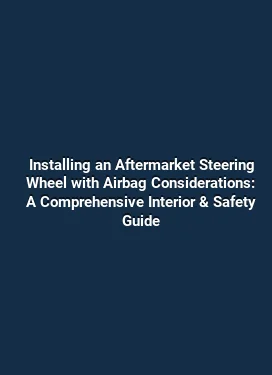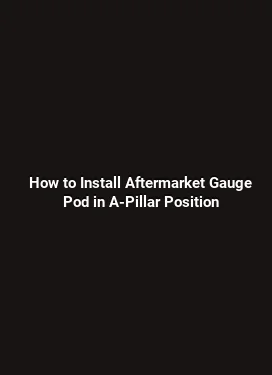Racing Net Window Installation for Track Safety Compliance
Racing facilities require robust safety measures to protect drivers, crew members, and spectators. A correctly installed window net system acts as a primary line of defense during high-speed events, reducing the risk of injury when vehicles contact barriers or roll over. This guide delves into the practical aspects of selecting, installing, inspecting, and maintaining window nets to meet track safety standards. It emphasizes real-world steps, detailed considerations, and preventive practices that track personnel can implement to sustain reliability across events and seasons.
Understanding Window Net Systems for Track Safety

Window nets are engineered to restrain a driver’s upper body within the cockpit in the event of a crash, while still allowing sufficient visibility for safe operation. The system typically consists of a durable net, mounting brackets, attachment hardware, and a load-rated latch or quick-release mechanism. Materials commonly used include high-strength synthetic fibers or laminated fabrics that resist tearing under impact while remaining flexible enough to avoid brittle failure at subzero temperatures or in direct sunlight. A well-designed installation accounts for net tension, anchor point strength, and the clearance around side windows to prevent snag hazards during vehicle rollback or chassis deflection.
From a safety engineering perspective, redundancy and accessibility are critical. Redundant mounting points reduce the chance of net detachment if a single bolt or bracket fails. Accessible latching devices allow quick removal for driver egress after an incident or during post-right, while also enabling rescue personnel to perform rapid access when necessary. The net’s weave and stitch quality contribute to load distribution; a uniform grid helps ensure that forces are dissipated rather than concentrated at a single point, which decreases the likelihood of catastrophic tears in the fabric.
Choosing the Right Window Net Design
Design choices must balance safety performance, ease of use, and compatibility with vehicle configurations. For open-wheel and closed-cockpit racing, preferred window net designs include the standard three-point attachment with vertical and horizontal mounting lines that align with the cockpit frame. Some setups use a two-point top edge anchored at the roll hoop, while others integrate a bottom edge that tucks under the seat or door seam to minimize glare and obstruction during entry and exit.
Key considerations when selecting a net include material strength rating, weave density, color contrast for visibility, and the inclusion of edge binding to resist fraying. High-strength nylon or polyester fibers often provide a favorable combination of tensile strength and flexibility. It is essential to verify that the net’s breaking strength exceeds the expected dynamic loads by a comfortable margin, taking into account vehicle mass, speed, and typical impact scenarios experienced on the track.
Net Material Properties and Durability

The net must maintain its integrity under repeated loading and environmental exposure. UV resistance is important for outdoor circuits to prevent material degradation from prolonged sun exposure. Abrasion resistance matters where the net may contact door guards or cockpit edges during operation. Some nets feature reinforced corners and extra stitching at high-stress zones to reduce the risk of edge unraveling after minor impacts or repeated cycling in a single season.
Durability testing is a practical step in a race facility program. Periodic checks on net tautness, attachment point security, and latch function help catch wear before it affects performance. Manufacturers often provide load-trace data and service life estimates; facilities should maintain a log of installation dates, replacement cycles, and any observed material fatigue to inform maintenance planning.
Installation Guidelines for Consistent Safety Performance
Correct installation is as important as the net’s material quality. The following steps outline a robust process that facilities can adopt to ensure consistent results across different vehicle models and track layouts.
First, prepare the mounting structure. Inspect roll bars, door frames, and cockpit edges for burrs or sharp edges that could abrade the net. Remove any rust, re-treat metal surfaces as necessary, and apply protective padding where brackets contact metalwork. The goal is to create a clean, smooth surface for bracket attachment with no interference to the net’s weave or movement.
Next, position the net so that it covers the window opening with adequate overlap on all sides. The top edge is typically anchored to the roll hoop or A-pillar, with side edges secured to frame members that remain stationary during cockpit flex. The bottom edge should not sag into the driver’s feet or interfere with pedal operation. Use evenly spaced fasteners to distribute tension and prevent localized stress that could lead to premature tearing.
Attachment hardware selection is crucial. Stainless steel or corrosion-resistant fasteners resist deterioration in varying track conditions. Locking nuts or applied thread-locking compounds reduce the chance of fasteners loosening during a race weekend. The net should be pre-stretched to a moderate tension before final tightening, ensuring a taut but not over-stressed installation that could excessively restrict movement or create binding during an emergency egress.
Locking mechanisms deserve careful attention. Quick-release latches should be accessible to the driver and rescue personnel without requiring tools. The release action must be intuitive and reliable even under fatigue or emergency lighting conditions. A test routine should verify that releases operate smoothly and that the net returns to its full open position after release, allowing rapid egress when necessary.
Step-by-Step Installation Checklist
- Inspect all mounting surfaces for integrity and cleanliness
- Choose secure anchor points with redundancy where feasible
- Align net to ensure uniform coverage with minimal slip risk
- Attach top and side edges with balanced tension
- Install bottom edge without restricting pedal movement
- Test latch mechanism under simulated load
- Perform a full drive-through check to confirm clearance
- Document installation date, parts used, and test results
Maintenance, Inspection, and Lifecycle Management
Regular maintenance extends the life of window nets and sustains safety performance. A formal inspection routine enables early detection of wear, environmental damage, or mounting looseness that could compromise the system. Inspections should occur at a minimum before and after each event, with more frequent checks during intense schedules or variable weather conditions.
Key maintenance tasks include measuring net sag, inspecting stitching for pulled threads, and examining corner reinforcements. If any signs of fraying, tearing, or loosening appear, the net and hardware should be replaced or re-tensioned according to the manufacturer’s guidelines. It is prudent to keep spare nets and hardware on hand to avoid delays between events and ensure a rapid restoration of full safety coverage.
environmental exposure can accelerate wear. Salt spray on coastal circuits, dust and debris from unpaved sections, and high humidity can affect fasteners and anchor points. A periodic cleaning regime helps maintain material performance; use mild detergents and avoid harsh solvents that could degrade fibers. After cleaning, ensure all attachment points are dry before reassembling to prevent corrosion or moisture-related weakening of fasteners.
Lifecycle planning involves scheduling replacements on a defined timeline, not only in response to visible wear. A data-driven approach considers the track’s climate, frequency of use, and historical incident data to estimate net replacement intervals. Documentation of every replacement builds a traceable safety history that supports compliance reviews and future procurement decisions.
Compliance, Documentation, and Operational Readiness
Safety programs in racing environments rely on clear documentation and consistent practices. Track operators should maintain comprehensive records for each window net, including serial numbers, material batch IDs, installation dates, test results, and refurbishment notes. These records support regulatory audits, insurance requirements, and ongoing quality assurance efforts by providing transparent evidence of maintenance discipline.
Operational readiness also depends on training. Staff responsible for installation and inspections should receive hands-on coaching that covers correct mounting techniques, latch operation, and emergency egress procedures. A standardized inspection form helps ensure that all critical aspects are reviewed during each check. Periodic audits by senior safety personnel can verify adherence to procedures and identify opportunities for process improvements.
Operational Scenarios and Practical Examples
Consider a mid-season test day where multiple car configurations are tested. A consistent net design with modular mounting points simplifies swaps between car models and reduces downtime. In this scenario, technicians can quickly detach the net from one vehicle and reattach it to another, provided the anchor positions align and net length is sufficient. This flexibility minimizes track downtime while maintaining high safety standards.
In rain-impacted conditions, visibility and grip on the net surface may be affected. Selecting nets with brighter color accents enhances visibility through rain-slicked glass, aiding drivers in maintaining awareness. Additionally, ensuring that latches remain operable with wet hands is essential; designing recessed latch areas with proper drainage can prevent water accumulation that impedes operation.
Design Integration with Vehicle and Cockpit Geometry
Window nets should be evaluated in the context of vehicle geometry and cockpit ergonomics. Some chassis designs place the window opening close to the driver's elbow or shoulder, increasing the risk of contact with the net during aggressive maneuvers. In such cases, padding or shield pieces may be added along the inner frame to reduce potential injury and prevent net snagging. The goal is to preserve driver mobility while delivering effective restraint in the event of a crash.
Alignment with other safety devices, such as arm restraints or window net guides, can further reduce injury risk. Coordinating the net system with these components ensures coherent operation and prevents clashes during rapid forward or lateral movements of the vehicle. A holistic approach to cockpit safety pays dividends in overall incident response times and training efficiency for crews.
Practical Tips for Achieving Consistency Across a Facility
Standardization across multiple bays or tracks helps reduce variation in safety performance. Use a single net model with uniform dimensions and mounting hardware wherever feasible. Create a part library that includes replacement nets, brackets, fasteners, and release mechanisms to simplify procurement and maintenance. A standardized inspection cadence, paired with a clear escalation path for worn components, helps ensure that any safety deviation is promptly addressed.
Engage with manufacturers and safety consultants to review installation practices and perform periodic third-party inspections. Independent evaluations can validate that the latest safety features are incorporated and that the installation adheres to recognized best practices. Document these evaluations to maintain a transparent safety program that gains trust from drivers, teams, and regulators.
Finally, incorporate scenario-based training that simulates real incidents. Drills that include net deployment, quick-release operation, and rescue access help staff internalize correct procedures under pressure. These exercises, conducted under controlled conditions, reinforce knowledge and reduce the likelihood of human error during actual events.
In essence, the successful installation and ongoing maintenance of window nets hinge on a disciplined approach that blends robust materials, precise mounting, proactive inspections, and continuous learning. By embedding these practices into daily operations, race facilities can sustain high safety performance, minimize downtime, and foster confidence among participants and spectators alike.






